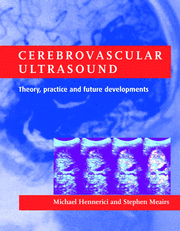Book contents
- Frontmatter
- Dedication
- Contents
- List of contributors
- Preface
- PART I ULTRASOUND PHYSICS, TECHNOLOGY AND HEMODYNAMICS
- PART II CLINICAL CEREBROVASCULAR ULTRASOUND
- (i) Atherosclerosis: pathogenesis, early assessment and follow-up with ultrasound
- (ii) Extracranial cerebrovascular applications
- (iii) Intracranial cerebrovascular applications
- 18 Transcranial Doppler ultrasonography and vasospasm after subarachnoid hemorrhage
- 19 Intracranial cerebral artery stenosis and occlusion
- 20 Arteriovenous malformations
- 21 High intensity transient signals
- 22 Transcranial Doppler monitoring during carotid endarterectomy
- 23 Cerebral vasoreactivity
- 24 Intracranial venous diseases: the role of ultrasound
- PART III NEW AND FUTURE DEVELOPMENTS
- Index
22 - Transcranial Doppler monitoring during carotid endarterectomy
from (iii) - Intracranial cerebrovascular applications
Published online by Cambridge University Press: 05 July 2014
- Frontmatter
- Dedication
- Contents
- List of contributors
- Preface
- PART I ULTRASOUND PHYSICS, TECHNOLOGY AND HEMODYNAMICS
- PART II CLINICAL CEREBROVASCULAR ULTRASOUND
- (i) Atherosclerosis: pathogenesis, early assessment and follow-up with ultrasound
- (ii) Extracranial cerebrovascular applications
- (iii) Intracranial cerebrovascular applications
- 18 Transcranial Doppler ultrasonography and vasospasm after subarachnoid hemorrhage
- 19 Intracranial cerebral artery stenosis and occlusion
- 20 Arteriovenous malformations
- 21 High intensity transient signals
- 22 Transcranial Doppler monitoring during carotid endarterectomy
- 23 Cerebral vasoreactivity
- 24 Intracranial venous diseases: the role of ultrasound
- PART III NEW AND FUTURE DEVELOPMENTS
- Index
Summary
Introduction
The introduction of transcranial Doppler (TCD) ultrasound in 1982 (Aaslid et al., 1982) was followed by a period of enthusiastic clinical application, particularly during carotid endarterectomy (Padayachee et al., 1986; Naylor et al., 1991). However, this initial enthusiasm was tempered by the publication of reports that its routine use was not associated with any significant reduction in the overall risk of stroke during carotid surgery (Bornstein et al., 1996).
However, as with virtually every other monitoring modality, meaningful debate as to the role of TCD during carotid endarterectomy (CEA) has primarily been limited by a failure to ask the right questions (Naylor, 1999). The main problem remains that most monitoring methods have concentrated solely on identifying those at greatest risk of suffering hemodynamic failure during carotid clamping and, thereafter, to develop criteria for the selective use of a shunt. The paradox, however, is that hemodynamic failure is a relatively rare cause of perioperative stroke (Krul et al., 1989), the commonest single cause being thromboembolism (Riles et al., 1994).
Accordingly, should the stroke rate remain unchanged, following implementation of a policy of intraoperative TCD monitoring, there is then a tendency to simply discredit TCD without asking further critical questions (Naylor, 1999). In short, how can TCD be blamed for a stroke that was due to embolization of luminal thrombus following restoration of flow if no attempt was made to identify and remove the thrombus in the first place?
- Type
- Chapter
- Information
- Cerebrovascular UltrasoundTheory, Practice and Future Developments, pp. 317 - 323Publisher: Cambridge University PressPrint publication year: 2001



